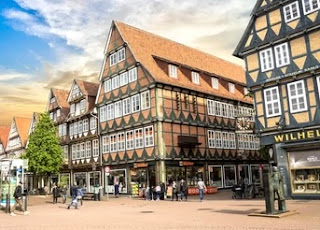With six crowned kings and queens all descended from the Royal dynasty, the province has a close tie to Great Britain. The line began with King George I in 1714 and continued until Queen Victoria's demise in 1901. Of course, there are many other reasons to go, but this history is still evident in the numerous castles and country homes that dot the landscape.
Hanover
On the Leine River, in the German state of Lower Saxony, is the capital city of Hannover. The Saxons founded it in the tenth century, and in the twelve, it joined the Hanseatic League, a significant economic association of northern European cities. From 1814 to 1866, it served as the Kingdom of Hanover's capital, before Prussia conquered it and made it a part of the German Empire. Despite significant damage from World War II, the city's historic core has been rebuilt. Thankfully, the city hall, the Neues Rathaus, was mostly unharmed. It is a beautiful example of Renaissance Revival architecture and was first built in 1913. Utilize the distinctive arched lift to go to the top for stunning city views.
The Herrenhausen Gardens, which date to the 17th century, are located nearby. The Berggarten, the Georgengarten, and the Welfengarten encircle the Great Garden, one of the most notable Baroque gardens in all of Europe. 18 statues, each coated in sparkling gold and modeled after ancient artifacts, line the outdoor Garden Theatre. The Aviation Museum in adjacent Laatzen is a permanent display that includes 38 aircraft, 800 aircraft models, and more than 30 engines. A group of aviation enthusiasts founded it in 1987, and today it houses a variety of modern and historic aircraft. A reproduction of the Wright Brothers' Flyer, the world's first successful powered aircraft, as well as a Messerschmitt Bf 109 fighter and a MiG-21 jet, are among the highlights.Hamelin
Hamelin, which is 50 kilometers north of Hanover, is well-known for its connection to the Pied Piper, a folktale about a piper who abducted the town's children. From 1636 to 1705, when it joined the Kingdom of Hanover, it was the seat of the Principality of Calenberg, which is situated on the Weser River. The Pied Piper House, which was erected in the 1600s and boasts a mural showing the piper's procession, is one of several references to the well-known piper in the charming historical center. A contemporary sculpture featuring a piper and kids is also located right outside the train station. The legend is finally placed in its medieval context by the Museum Hameln.
Wolfsburg
Wolfsburg's Autostadt is a tourist destination next to the Volkswagen factory, 90 kilometers east of Hanover. It began as a car delivery center but has now expanded to include many exhibitions about cars. There are exhibitions focusing on sustainability and other topics, as well as pavilions for each Volkswagen brand, spread across a surface area of more than 28 hectares.
• Your brand-new Volkswagen is still available for pickup from the Autostadt Delivery Towers in this location. The two cylinder-shaped, 48-meter-tall futuristic towers resemble glass silos and are lighted at night by LED lights that continuously change color. 400 brand-new Volkswagen automobiles are stacked inside, and a sophisticated lift system transports them to consumers.
The ZeitHaus, a museum that chronicles the development of the car from its inception to the present, is arguably the most fascinating. It's a wonderful collection of vintage automobiles that includes Mercedes-Benz, Rolls-Royce, and Bentley classics in addition to Volkswagens.
Marienburg Castle
About 30 kilometers south of Hannover sits Marienburg Castle, which appears to be older than it is. King George V of Hanover gave it to his wife as a birthday gift in the Gothic Revival style between 1858 and 1867. A moat and a park encircle the complex of buildings, which also includes a keep, a chapel, a library, and a ballroom. The kitchens, complete with pots and pans from the 19th century, are of great importance.
Wolfenbüttel
Jägermeister's birthplace, Wolfenbüttel, is 80 kilometers southeast of Hanover. The historical center, which has largely escaped destruction from the conflicts fought during its lengthy history, is more interesting. The Dukes of Brunswick-Lüneburg lived in Wolfenbüttel Castle, a Renaissance palace, which is accessible via its winding alleyways, half-timbered homes, and charming shops. It now serves as a museum, displaying various works of art, pieces of furniture, and other artifacts. In Wolfenbüttel, Duke Henry Julius established a court library in 1572. He donated numerous priceless items from his personal collection, including old monastic writings that he had taken after he banned Catholicism. As the Herzog August Bibliothek, it is one of Germany's oldest and most significant libraries and currently holds more than a million books.
Celle
On the banks of the River Aller sits the nearby city of Celle. It is well-known for its stunning castle, the Schloss Celle, which the Dukes of Brunswick-Lüneburg lived in and was constructed in the Renaissance style in the thirteenth century. The Residenzmuseum, which features a range of works of art and furnishings from the ducal era, is presently housed in the castle. Over 500 half-timbered homes, many of which are from the 16th century, can be seen in Celle's well-preserved Altstadt, or Old Town, which has a long history. The Bomann Museum, which displays the history and cultural legacy of the town, is also located there. Numerous exhibits are available at the museum, including a sizable number of works by local painter Otto Modersohn.






